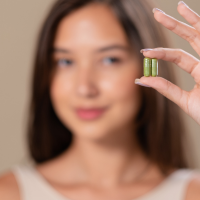Acne is a common dermatological concern that manifests itself through comedones, papules and pustules, affecting the pilosebaceous unit of the skin. Although it is usually associated with adolescence, this multifactorial condition can affect people of all ages. One of the factors that is often overlooked is increased sebum production.
Causes of acne due to ingestion of complex B
Drug-induced acne presents as monomorphic lesions, including inflammatory papules or papulo-pustules. These lesions are usually related to the administration of certain medications and tend to appear in unusual, non-seborrheic areas of the skin.
A surprising, but relevant cause is the excessive administration of vitamin B12. When high doses of this vitamin are consumed, usually greater than 5-10 mg per week or for prolonged periods, acne breakouts can be triggered. Similarly, cases of vitamin B1 or B6-induced skin rashes have been documented, usually appearing days or weeks after starting treatment. These acneiform conditions usually improve completely when you stop taking the vitamins, since they usually aggravate common acne or cause a rash with similar characteristics.
Symptoms and Clinical Manifestations
Clinically, vitamin B acne manifests with the appearance of papules or pustules in specific areas. The most affected areas are usually the face, especially the forehead and chin, as well as the anterior and posterior thorax. In more severe cases, these lesions can extend to the arms, but in general, they are not accompanied by comedones or cysts. Fortunately, this type of acne usually improves spontaneously and completely within one to eight weeks, with an average of two to three weeks, without scarring.
Mechanism of action
Although the exact mechanism behind this reaction is not yet fully understood, it is believed to be related to the suppression of vitamin B12 synthesis by the bacteria Cutibacterium acnes. This suppression leads to the increase of vitamin B precursors, which triggers alternative pathways that increase the production of porphyrins in the skin. These porphyrins release pro-inflammatory substances that promote the appearance of acne-like lesions. Although this theory is valid in many cases, it is important to note that some patients may develop this acneiform reaction due to their unique susceptibility to the action of vitamin B12.
Treatment and Prevention
Treatment of vitamin B-induced acne is similar to that used for acne vulgaris. It may include topical and oral antibiotics, and in more severe cases, isotretinoin may be prescribed at low doses for a period of six months. It is essential that medical professionals adapt treatment according to the severity of the disease and that they inform patients about possible reactions or adverse effects caused by taking excessive vitamins.
Conclusion
Acneiform reactions associated with the administration of medications, including vitamins, are an important aspect to consider in medical care. It is essential for the personal physician to provide appropriate treatment guidelines and education about possible side effects to prevent health problems in patients. Ultimately, it is strongly recommended to avoid consuming supplements or medications without the supervision of an aesthetic medicine specialist. Recover healthy skin with the help of experts at the Aesthetic Medicine Clinic. Contact us today!


